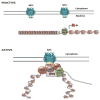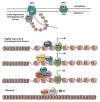Nuclear pore complexes and regulation of gene expression
- PMID: 28088069
- PMCID: PMC5505778
- DOI: 10.1016/j.ceb.2016.12.006
Nuclear pore complexes and regulation of gene expression
Abstract
Nuclear pore complexes (NPCs), are large multiprotein channels that penetrate the nuclear envelope connecting the nucleus to the cytoplasm. Accumulating evidence shows that besides their main role in regulating the exchange of molecules between these two compartments, NPCs and their components also play important transport-independent roles, including gene expression regulation, chromatin organization, DNA repair, RNA processing and quality control, and cell cycle control. Here, we will describe the recent findings about the role of these structures in the regulation of gene expression.
Copyright © 2017 Elsevier Ltd. All rights reserved.
Figures


References
-
- Callan HG, Tomlin SG. Experimental studies on amphibian oocyte nuclei. I. Investigation of the structure of the nuclear membrane by means of the electron microscope. Proc R Soc Lond B Biol Sci. 1950;137:367–378. - PubMed
-
- Raices M, D’Angelo MA. Nuclear pore complex composition: a new regulator of tissue-specific and developmental functions. Nature reviews Molecular cell biology. 2012;13:687–699. - PubMed
Publication types
MeSH terms
Substances
Grants and funding
LinkOut - more resources
Full Text Sources
Other Literature Sources

